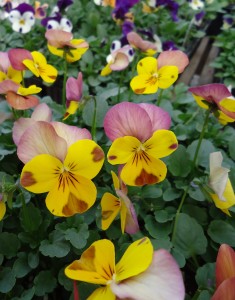Don’t let those cute little faces fool you — pansies are tougher than they look — and unafraid of a little cold weather. However, pansies are not tough to grow and offer a lot of cool season color while asking only a little in return. Growing pansies is an easy, early way to start the Spring celebration, and you’re invited! Here’s how…
5 Reasons to Plant Pansies this Spring:
- They’re great for beginners
- Offer many varieties and colors
- Produce wonderful color in cool season
 s
s - Some have a sweet fragrance
- Great for containers and flowerbeds
Start smart.
Pansies actually do best in cooler weather, and therefore are usually planted in Spring or Fall. You can start pansies from seed, but it’s much more convenient to buy bedding plants at your favorite garden center. When you do, choose plants that are compact, bushy and dark green with plenty of buds.
You don’t have to contain yourself.
You can plant pansies directly into flowerbeds in the landscape or in containers. If you’re unfamiliar with container gardening, watch our video. For best results start with a high-quality potting medium. If flowerbeds are your thing, pansies can go into the ground just as soon as the soil is workable.
Keep it light.
Choose a site with full sun. This keeps them warm when temperatures are cool and helps them produce the colorful blooms they are famous for. Planting in an area with too much shade will hurt the bloom.
Make sure they’re well-grounded.
Pansies are not fussy, but prefer a moist, slightly acidic soil with good drainage. Plant your seedlings about six to eight inches apart and mix in an organic starter plant food into the soil while you are planting. We recommend Espoma Bio-tone® Starter Plus. Later in the season, feed them once again with Espoma Flower-tone®.
A thirst for beauty.
In the Spring, there is typically enough rain to help the plants become well established — about an inch per week. If not, water the plants to make up the difference. NEVER water pansies in late afternoon or evening — this will encourage disease.
Don’t miss mulch.
Mulch around pansies to conserve moisture and reduce weeds; especially if you cut them back in the hottest part of summer. Use a couple of inches of organic material or compost.
Off with their heads.
To extend the bloom, remove old flowers once they fade. This is known as “dead heading.”
All good things…
Sorry, but pansies decline with hot weather. You can cut them back and mulch them to keep your hopes alive for Fall. Or, painful as it may be, you can just replace them with summer-flowering annuals. The good news is that you can plant more pansies as the weather cools — probably September. The plants should over-Winter nicely and be there to greet you with smiling faces in Spring.
It’s no wonder that pansies have been a favorite for generations. They’re beautiful, versatile and easy to grow. If you follow our simple guidelines, we’re confident that pansies will reward you with the spectacular display of early Spring color you deserve after a long Winter.

